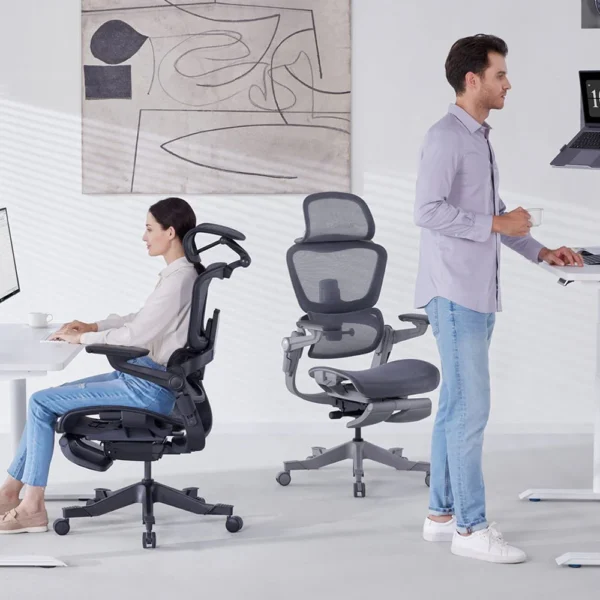In today’s world, the importance of a well-designed workspace cannot be overstated. Ergonomic furniture has become a crucial element in enhancing productivity and ensuring comfort. Transforming your workspace with brilliant furniture promotes health and boosts efficiency. This article explores the benefits of ergonomic furniture and how to integrate it into your workspace for optimal results.
Creating an ergonomic workspace is essential for modern professionals. For example, using Hinomi’s ergonomic furniture can significantly improve comfort and productivity. Reducing physical strain helps promote better health. Integrating innovative ergonomic solutions can lead to optimal results in any work environment.
The Importance of Ergonomic Furniture
They are designed to support the natural posture of the human body, reducing strain and enhancing comfort. Traditional office furniture often fails to provide the necessary support, leading to various health issues such as back pain, neck strain, and repetitive stress injuries. It addresses these problems by promoting proper alignment and reducing pressure on critical areas of the body.
Critical Benefits of Ergonomic Furniture
1. Improved Posture
One of the primary benefits of this furniture is its ability to improve posture. Ergonomic chairs, for instance, are designed with adjustable features that support the spine’s natural curve, reducing the risk of developing musculoskeletal disorders. By encouraging correct posture, these chairs help prevent discomfort and long-term health issues.
2. Enhanced Comfort
It is designed with user comfort in mind. Adjustable chairs, desks, and accessories allow users to customise their workspace to their needs. Features like lumbar support, adjustable armrests, and cushioned seating contribute to a more comfortable working environment, reducing fatigue and increasing productivity.
3. Increased Productivity
A comfortable and well-organised space can significantly boost productivity. It helps minimise distractions caused by discomfort, allowing individuals to focus better on their tasks. By reducing physical strain, employees can work more efficiently and for more lengthy periods without experiencing fatigue.
4. Health Benefits
It offers numerous health benefits. Promoting proper posture and minimising strain on the body helps prevent common workplace injuries such as carpal tunnel syndrome and lower back pain. Additionally, ergonomic desks that allow for sitting and standing can reduce the risks associated with extended sitting, such as obesity and cardiovascular diseases.
Essential Ergonomic Furniture Pieces
1. Ergonomic Chairs
They are a cornerstone of any workspace. These chairs feature adjustable seat height, backrest, and armrests to provide maximum support and comfort. Look for chairs with lumbar support and a waterfall seat edge to minimise pressure on the thighs and improve circulation.
2. Sit-Stand Desks
Sit-stand desks allow users to substitute between sitting and standing throughout the day. This flexibility helps reduce the dangers associated with prolonged sitting and promotes better posture. Adjustable height desks are available in manual or electric models, making it easy to switch positions as needed.
3. Ergonomic Keyboards and Mice
Traditional keyboards and mice can strain wrists and hands. Split keyboards, angled vital designs, and vertical mice offer a more comfortable typing and steering experience. The goal of https://qwertybro.com is to elevate everyone’s typing experience.
4. Monitor Stands and Arms
Proper monitor placement is essential for reducing neck and eye strain. Monitor stands and arms allow users to adjust the height and angle of their screens to achieve an optimal viewing position. Ensuring that the top of the monitor is at or slightly below eye level can help maintain a neutral neck position.
Tips for Creating an Ergonomic Workspace
1. Assess Your Needs
Before purchasing furniture, assess your specific needs and preferences. Consider factors such as your height, the nature of your work, and any existing health issues. This evaluation will help you choose the right furniture with the best support and comfort.
2. Customise Your Setup
They are designed to be adjustable. Take advantage of these features to customise your workspace. Position your monitor at eye level and within arm’s reach. Use keyboard trays and mouse platforms to maintain a neutral wrist position.
3. Incorporate Movement
Incorporate Movement into your day-by-day routine to reduce the dangers associated with prolonged sitting. Take short breaks to stretch and walk around. Simple shoulder rolls and neck stretches can help alleviate the pain and improve circulation.
4. Maintain a Clean and Organised Workspace
A cluttered workroom can contribute to stress and discomfort. Keep your desk clean and organised to create a more pleasant and efficient working environment. Use cable management solutions to keep cords out of the way and reduce visual distractions.
Transforming your workspace with ergonomic furniture is an investment in health and productivity. Ergonomic chairs, sit-stand desks, and supportive accessories improve comfort, reduce strain, and enhance overall well-being. For example, Hinomi’s ergonomic furniture offers various options to meet different needs. You can create a workspace that promotes ergonomic excellence by assessing your needs, customising your setup, and incorporating Movement into your routine. Embrace the benefits of ergonomic furniture and experience the positive impact on work and health.



